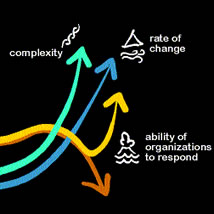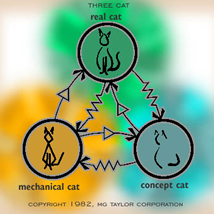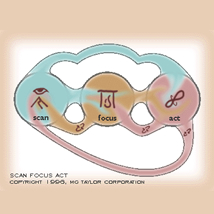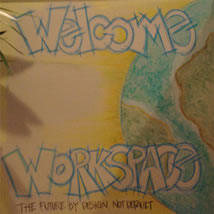an Integrated
Education Process |
| In 1983, MG Taylor did a DesignShop® 5 day event for the U.S. Corps of Engineers. The focus of the exercise was to redo the Captain’s Training program as a model program to modernize training processes throughout the Army. At the time, the Army was trained and equipped in three different doctrines and Battle Doctrines we changing faster than the Army could respond. The Air Land Battle 2000 had just been introduced and this required a radical change in how the Army looked at the field of battle and the role of it’s people. Change was coming faster than the ability of the organization to respond. |
|
| The MG Taylor Rate of Change Model describes one of the basic challenges we addressed when we created our System and Method. |
|
click on the model for more information |
| The Design Shop was a great success and, because all of the stakeholders from though out the Army were represented by participants, the Army Chief of Staff approved the program within a week. The program was started in a few months. All of this took 18 months to three years off the typical time-to-get-started for an educational program in the service at that time. In addition, the teaching program itself was altered. Not just the content to be requisite with the new Battle Doctrine but also the method of learning which relied on less “sit and get” and more experiential learning. The total time was reduced. The Corps of Engineers’ new training became a standard for the entire Army demonstrating the value of rapid prototyping before scaling a program. The Corps build a navCenter - they called it a Fusion Center - for their OD group at Ft. Belvoir outside of Washington DC. This was the second navCenter ever built. This effort was called training and there certainly was a great deal of that in the curriculum. There was also a fair measure of education. These are solders who are practicing engineers who also have to be able to build bridges over rivers between two armies exchanging live fire. They have to clear land minds, build air bases and restore the infrastructure of cities. You do not do all of these things and stay alive by being dumb. |
| The Model above, in my original hand drawn notes, was developed for the Ft. Belvoir Center. It remains to this day the basic process model for how the navCenter can integrate the learning modalities, with experience and work. You can see that it is closely coupled with the 3 Cat and Scan Focus Act Models and their related processes. It is the navCenter function which allows the entire curriculum for the 21st Century to be employed by teacher and student so that every student, every year, can engage in the full curriculum, in successive iterations at an appropriate level, as determined by a mutually agreed upon study plan which incorporates the full suite of learning modalities. This method also directly relates learning to life goals, further learning options and work opportunities for the older student-worker. As a system, it becomes the administrative method for the learning method I presented to members of the San Francisco School System in 1956. |
| This Model, and use of a navCenter, can be effectively used with the Capacity Guide concept in businesses to more effectively match human development to work opportunities. This was loosely done in the 1990s in two “corporate university” projects we were involved in. As of this writing, February, 2011, there are two education projects which present an opportunity for the first full scale test of these means to education: SERP and the Masters Academy and College projects. It is notable that the time from concept to development and first robust application has been a 55 year span. A time period which has seen as much global change than has occurred in centuries and in which Humanity faces this much again in likely half the time and possible less. If learning is not informed as much by probable futures, as it is from the present and past, there is little hope for a smooth transition to the next social-economic stage of Humanity. As a system, we are dangerously discounting our human potential future. the environment - the integration of physical space, processes and technology - for learning is seriously deficient. This is why good and even great education efforts fail outright or even if locally successful are not scaling at the rate and scope necessary. |
insert here:
rate of change, 3 cat, scan focus act, etc.
|
 |
| These Models in context of the Army experience and Administrative Method Model (developed for FT. Belvoir address a number is issues systemic to education in general. |
|
| The Rate of Change Model came from an experience I had in 1961. This was the first “hit” that lead me, in the early 70s, to start thinking deeply about the sweeping changes which were changing our society at a rate greater than our response capability and what kinds of actions were therefore appropriate. |
|
 |
|
 |
| The Scan Focus Act Model is simple and obvious yet rarely employed in an operational way. |
|
 |
| This essay addresses a major thesis of MG Taylor’s work which is the relationship of our society’s ability to adequately respond to the global change which is the consequence of the sum of all human actions. Nowhere is this more critical than in the field of education. The present trends do not add up to a health future. |
|
|
Process Compoenets of the Model: |
| There
are four primary process components to the “Army” administrative method model: |
|
| The premise of the model rest on several fundamental aspects of learning which I discovered by experience with my own education and Gail and formulated when we designed the MG Taylor System and Method. Numerous other learn methods have arrived at the same conclusion by their own means, expressed in their own language. None of these aspect are new. What is rare is that they are applied and rarer still applied as a system. |
| There are many cognitive styles of learning, thinking and designing. Each individual, and groups as a composite, will employ some of these in preference to others. Competency in all of them is necessary while mastery of a few is usually sufficient to the task or circumstance at hand. |
|
|
|
|